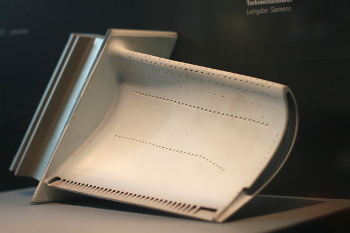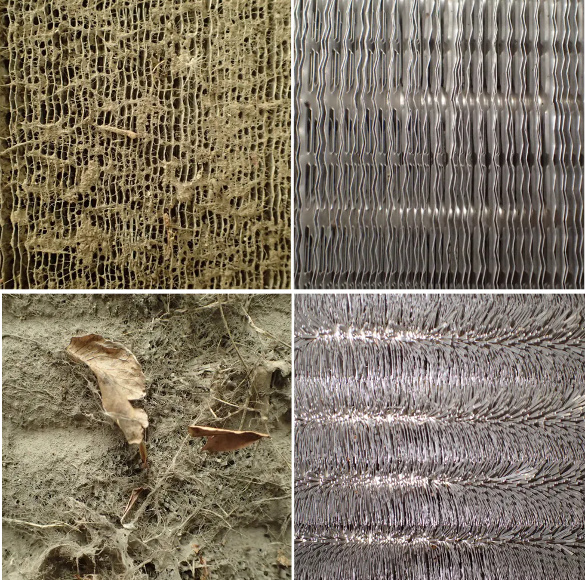Heat Transfer
September 28, 2020
Everybody seems to
love duct tape. Its name derives from its intended use as a means to
seal joints in
air ducts, but the variant on its name,
duck tape, comes from one of the original
materials of its
manufacture,
duck cloth, which is a heavy,
plain woven cotton fabric. It's often recommended that
automobile drivers include a roll of duct tape in their automobile
emergency repair kit, since it's useful for temporarily attaching loose
parts and stopping
leaks in
radiator hoses.
I was happy to have some duct tape in my
car many years ago when
steam emerged from under the
hood, a sure sign of radiator hose
rupture. An automobile radiator is designed to "radiate"
heat developed in the
engine; but, in a strict
physics sense, automobile radiators
transfer just a little heat to the
environment by
radiation, the major transfer being done through
conduction.
Air flow through the radiator
fins, caused by motion of the automobile or by an
electric fan, transfers heat from the radiator to
air through contact with the
metal, which is in contact with the
engine coolant.

A Ford Model T touring car, 1925.
The Model T, the first affordable automobile, was produced from 1908 through 1927 using assembly line mass production techniques. Sixteen and a half million Model T automobiles were sold.
The first production units had a radiator, and also a coolant pump as in modern automobiles. Later units used thermosiphon flow of coolant instead of a pump to transport coolant to the radiator.
(Modified Wikimedia Commons image by Lars-Göran Lindgren.)
Radiators are required for automobiles, since the fraction of heat
energy of their
internal combustion engine that's converted to useful
work is small. This fraction is called the
thermal efficiency, and it's only about 25-35% in today's automobiles, so 65-75% of
fuel is merely
burned to create unwanted heat. About half of this
waste heat is transferred to the environment through the hot
exhaust gas, and the other half through the radiator.
The reason for all this heat in automobile engines and other engines is a consequence of a fundamental principle of
thermodynamics that you need a
temperature difference to do
work. This was discovered in 1824 by
Sadi Carnot in his investigation of
heat engines, and this principle is codified in the
second law of thermodynamics. Carnot defined a maximum
efficiency,
η, as
η = 1 - (TC/TH)
where T
C is the temperature of a cold
reservoir, and T
H is the temperature of a hot reservoir. When there is no temperature differential, T
H is equal to T
C, and the efficiency is zero.
The formal name for a
radiator found in automobiles and other equipment is a
heat exchanger. Heat exchangers transfer heat between two or more
fluids, and an automobile radiator exchanges heat between a first fluid, the engine coolant, and a second fluid, air. Many homes have
central air conditioning with an outside heat exchanger. Inside the house, heat from indoor air transforms a cool
refrigerant liquid to a hotter
gas. Outside the house, the refrigerant gas is
compressed and passed through a large
coil, called a
condenser coil, that's
thermally coupled to
metal fins that expel heat to the environment and turn the refrigerant back to a liquid.
Conventional wisdom says that the
efficiency of heat exchangers in
residential central air conditioners will be hampered by
dirty fins, since dirt will reduce air flow and act as a
thermal barrier coating. Thermal barrier coatings are used to good advantage on
gas turbine engine blades, since they allow a higher operating temperature, and engine efficiency increases as temperature increases. Any thermal barrier in a heat exchanger would defeat its purpose, so people will periodically clean their outside condenser units with a
water spray from a
garden hose.

A Siemens turbine engine blade with a thermal barrier coating.
High performance blades such as this have small holes for air cooling of the blade material.
(Wikimedia Commons photo by Bin im Garten. Click for larger image.)
While folk wisdom is considered true since it often has a convincing enough explanation,
scientists demand better
proof, and that's proof through
experiment.
David Yuill, an
assistant professor of
architectural engineering at the
University of Nebraska-Lincoln, and Mehdi Mehrabi, an architectural engineering
graduate student, conducted a study of how dirt might impeded the functioning of residential air conditioning.[2] Their study was funded by the
American Society of Heating, Refrigerating, and Air-conditioning Engineers, of which Yuill is a member.[2]
Yuill and Mehrabi removed condensers coated with real-world dust from residential air conditioning systems, and tested their performance in a
laboratory. They then cleaned these with water and a
commercial coil cleaning fluid, took note of the quantity of dirt removed, and retested them to find the difference in cooling capacity. Two examples appear in the figure, below.

Residential central air conditioning condenser heat exchanger fins, dirty and clean. Upper images show condenser fins with 7 grams of dirt per square foot before and after cleaning, while the lower images are for 17 grams of dirt per square foot. Note the poor state of the metal fins in the image at the lower right, which might be the result of too aggressive a cleaning. (Images by Mehdi Mehrabi from ref. 2, released under a Creative Commons License.[2] Click for larger image.)
The
researchers found that, contrary to expectations, pre-cleaned air conditioner condensers sometimes perform better than clean ones. The
experimental findings, as shown in the
chart, had the change in condenser coil heat transfer performance after cleaning range from a 7% increase to a 7% decrease, with an
average change of essentially zero. While a condenser with 7 grams of dirt per square foot (585
mg/
m2) showed a 7% improvement in function with cleaning, another with 17 grams of dirt per square foot (1550 mg/m
2) had a 7% worse performance after cleaning.[2]

Air conditioner condenser performance change with cleaning. (Created using Gnumeric from data in ref. 2.)
The study conclusion is that cleaning your air conditioner condenser might make it more efficient, and it might make it less efficient. Since cleaning doesn't appear to make any difference, skipping this task shouldn't make you feel
guilty. However, Yuill admits he will still clean his when it's so dirty that he can't see the metal fins. As Yuill writes,
"As news of our findings spreads, I’m bracing for some unpleasant responses from people who might lose out if the condenser-cleaning business dries up and others who simply refuse to accept that there was no basis for the conventional wisdom on this question."[2]
References:
- Jerald A. Caton, "Thermodynamics of Internal Combustion Engines: Examples of Insights," Inventions, vol. 3, no. 2, pp. 33ff., https://doi.org/10.3390/inventions3020033. This is an open access article with a PDF file here.
- David Yuill, "Skip this chore: Cleaning your air conditioner condenser probably won’t make it work better," The Conversation, March 22, 2019
Linked Keywords: Love; duct tape; seal (mechanical); joint (mechanical); duct (flow); air duct; material; manufacturing; manufacture; cotton duck; duck cloth; plain weave; plain woven; cotton; textile; fabric; automobile; driver; emergency repair kit; interchangeable parts; leak; radiator (engine cooling; hose (tubing); car; steam; hood (car); rupture; heat; internal combustion engine; physics; heat transfer; environment (biophysical); thermal radiation; conduction (heat); airflow; fin; electric fan; air; metal; antifreeze; engine coolant; Ford Model T; touring car; assembly line; mass production; coolant pump; thermosiphon; Wikimedia Commons; energy; work (physics); thermal efficiency; motor fuel; combustion; burned; waste heat; exhaust gas; thermodynamics; temperature; work (thermodynamics); Sadi Carnot; heat engine; second law of thermodynamics; efficiency; thermal reservoir; heat exchanger; fluid; central air conditioning; refrigerant; liquid; gas; compression (physical); coil (chemistry); condenser (heat transfer); thermal conductivity; thermally coupled; metal; fin; folklore; conventional wisdom; efficiency; residence; residential; dirt; dirty; thermal barrier coating; gas turbine engine; turbine blade; water; spray (liquid drop); garden hose; Siemens; hole; air cooling; material; Bin im Garten; folk wisdom; scientist; models of scientific inquiry; proof; experiment; David Yuill; assistant professor; architectural engineering; University of Nebraska-Lincoln; postgraduate education; graduate student; ASHRAE; American Society of Heating, Refrigerating, and Air-conditioning Engineers; laboratory; commerce; commercial; gram; square foot; Creative Commons License; research; researcher; experimental; bar chart; average; mass; mg; meter; Gnumeric; guilt (emotion); guilty.